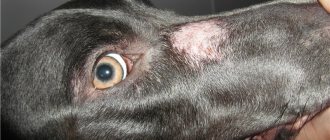Even experienced breeders often encounter health problems with their pet that baffle them, for example, sometimes the dog has abdominal cramps and it is not always possible to recognize them. The animal cannot explain the essence of the problem, and even in those situations when you manage to determine the location of pain, it is quite difficult to understand the cause and its nature. In such situations, you must immediately make an appointment with a veterinarian. This material has been prepared for informational purposes, and the problem that will now be discussed is precisely cramps in the abdominal area.
Causes of appearance and why the dog does not allow his belly to be touched
In fact, specialists in such situations do not always begin by identifying the cause of the symptom. The fact is that in many situations it is much more important to relieve the pain first. It is also worth mentioning that in some situations the cause of spasms is not determined at all (when they are weak). In this case, most likely, the reason for their appearance was not serious. For example, an animal’s body could react in a similar way to a glass of cold water that did not contain any additives.
It is also worth mentioning hunger, which you should never bring your pet to. No, hunger will most likely not cause cramps, but they can appear from sudden and rapid eating. The dog will not eat in small portions and slowly, because if it wants to eat, it will quickly absorb even ordinary dry food, and in large quantities. This can lead to unpleasant consequences.
It is also worth noting volvulus, which is very typical for dogs, because it is quite easy to get it. In most cases, it can develop even due to the reasons that were just given. For this reason, for the dog’s safety, you should carefully monitor its entire diet: control the portion size yourself, make sure that it does not eat grass in large quantities (this is a natural process, you definitely shouldn’t scold the dog for this).
An important rule that will definitely help prevent the possibility of volvulus is that meals should be distributed throughout the day so that after them the dog rests and before them the same thing. Under no circumstances should you go for a walk at this time. Otherwise, the dog will definitely have serious health problems.
Also, do not forget about the existence of irritants. Practice shows that cases when various poisons or any irritating substances enter a dog’s body are not rare. There are a large number of dog owners who have lost interest in their pet or simply do not have the opportunity to play with them for a long time. This always leads to the animal looking for a way to have fun on its own. If your detergents are located on the lower shelves, then the chance that the dog will turn them over and swallow a little is quite high.
Fortunately, this problem definitely cannot be ignored. It is necessary to urgently take your pet to a veterinary clinic if you notice this. This is necessary even in situations where symptoms have not yet begun to appear, because the animal may die, but it would seem that only the dog’s stomach cramps have begun! Pay attention to such a disease as catarrh of the stomach, it also often affects the intestines. The essence of this disease is spastic contractions that most often occur after eating. It is important to show the animal to a veterinarian because this problem often causes a narrowing associated with the pyloric part of the stomach.
Let us also mention one more option, the essence of which is the possible contraction of the diaphragm (most often spasms occur only in the intestines, less often in the stomach). This disease is always accompanied by other characteristic symptoms. We are talking about vomiting, which is very pronounced and forces the dog to make movements unusual for it. The problem may also be a simple parasite infestation. Worms in dogs are not uncommon, and the number of roundworms can grow to such an extent that the intestines become seriously damaged.
Content:
Sometimes dogs experience convulsive contractions of the muscles of the limbs or the muscular wall of hollow organs (intestines, esophagus). This causes reasonable concern for owners, since such a situation may indicate a serious problem with the pet’s health. When we talk about spasms in dogs, we primarily mean involuntary contractions in the abdominal area, since spasms in the limbs are a completely different problem (for example, epilepsy is possible). In our case, the animal is hunched over, afraid of sudden movements, and tension is noticeable in the abdominal muscles.
Symptoms of spasms in an animal
The symptoms of spasms in an animal can vary and, as mentioned earlier, it is not always easy to distinguish it from other problems related to the health of the animal. Here are the most common accompanying symptoms, which are often observed along with the spasms themselves.
Severe pain
It is worth noting that in the vast majority of situations, ordinary spasms are accompanied by a strong and sometimes unbearable pain reaction. We also must not forget that symptoms, like the spasms themselves, can easily disappear and appear automatically. During “outbursts” of spasms, the dog may even begin to roll on the floor from terrible pain. Bizarre poses are also not uncommon. Experts note other symptoms in such situations that are also important to know.
Vomiting, nausea
Nausea, which gradually develops into vomiting, is also considered a characteristic symptom for such situations. Vomiting may occur after eating or, for example, when the animal wants to urinate. In other situations, this symptom does not always appear, but it is necessary to know about its existence. Other problems may be a secondary cause of these symptoms. It is worth noting that they are incredibly common in the parallel presence of stones in the gall bladder or even in the kidneys. Intestinal obstruction due to volvulus can also cause similar attacks of vomiting. Also pay attention to diarrhea, as it often accompanies vomiting in dogs.
Tension and enlargement of the abdomen
Among those symptoms that cannot be overlooked, we will highlight changes associated with the condition of the abdomen. The fact is that he gets very tense, and the dog begins to protect him. No matter how strange it may sound, you most likely will not be able to even touch the abdominal area, because the dog will try everything to prevent you from feeling it. There are known situations where even friendly dogs turned into aggressive individuals when spasms appeared. Everything even went so far as to bite the owner, which is definitely not normal.
Breathing problems
Veterinarians say that the dog will lose the ability to take deep breaths, and even small attempts to get air into its lungs will be difficult for it. This symptom is very dangerous, since the body will not receive the proper amount of oxygen for a long time. As for the other features of breathing, it is worth noting its hoarseness, despite the fact that it is superficial. This is especially noticeable during moments of improvement, when the spasms subside a little.
Problems with thermoregulation
In addition to breathing, other problems associated with the serious condition will arise. We are talking about the fact that the body will heat up and will not be able to cool down due to the complete absence of sweat glands. Thus, the dog’s general condition will noticeably worsen. If everything has reached this stage, and you have not yet contacted the veterinarian, then, unfortunately, the risk of death of the animal is very high. Between the temperature fluctuations that occur during the spasms themselves, the dog will feel a little better.
Decreased appetite
You should not try to feed your dog during cramps, because this will still not work due to vomiting. It is also worth noting that the animal itself will not eat food, and this applies even to those situations where the manifestations of spasms are small and the pain is mild.
Redness of the conjunctiva
If you cannot determine what is hurting your dog, look at his eyes. Most likely, if the problem lies precisely in spasms, the conjunctiva will be red. Of course, this sign cannot be used to judge the presence or absence of spasms, but it is quite possible to confirm the guess about the diagnosis.
Note! Stomach cramps in any breed of dog sometimes appear for only 2-3 minutes, but there are about 10 such manifestations per day. But it is worth understanding that this only happens when the cause is relatively harmless, that is, it cannot cause serious harm to health.
Russian Toy Forum
Beginning
Group: beginners Messages: 13 Registration: 9/29/2011
Guru
Group: vip-users Messages: 593 Registration: 2.3.2011 From: Moscow Region, Novopodrezkovo
Were there any ticks on the dog? “Typical symptoms of acute piroplasmosis:
lethargy, weakness, elevated temperature - up to 40 - 42 degrees - as a rule, at this stage, dog owners are not yet very concerned and do not seek veterinary help. Sometimes after this stage, which lasts 1 to 2 days, there may be a slight improvement in the condition.
As the disease progresses, the general condition worsens significantly, the dog refuses to eat, and the urine becomes dark, greenish-brown, or even black. The color of urine is the most striking symptom of piroplasmosis in dogs, but in the summer when the disease occurs, owners rarely notice a change in the color of urine, because the color is invisible on the ground and grass, which is why contacting the veterinarian is delayed.
The mucous membranes are pale or with signs of jaundice. There may be an enlargement of the liver and spleen.
Quite often, piroplasmosis (babesiosis) in dogs can be accompanied by vomiting and diarrhea, sometimes with blood.”
How is the diagnosis made?
Before we describe in detail the action plan for cramps in the stomach area, let’s look at what signs experts use to make a preliminary diagnosis (or a final one, if there is no time to check it or the side symptoms do not raise questions). Only the most serious situations will be analyzed in detail, since the remaining options are not a dangerous problem.
Gastric volvulus. This situation is incredibly dangerous. A characteristic symptom of gastric volvulus is a significant enlargement of the entire abdomen. Experts also identify other deteriorations that were described in the symptoms. The veterinarian always tries to confirm the diagnosis using a probe or x-ray, but if there is very little time and the diagnosis is beyond doubt, then this stage can be neglected.
Relatively harmless situations. When the problem is not so serious, the veterinarian is obliged to identify the diagnosis. This is important because when treating one disease with methods that help another, success will not be achieved. As mentioned earlier, it is easy to endure such spasms, since they do not last long, but are repeated after some time. But if left untreated, even harmless causes can develop, for example, into rupture of internal organs.
Provoking spasms by worms. Tapeworms, which quite often choose the body of dogs as a place of life. They almost always parasitize in the intestines, and in the initial stages this is only accompanied by low appetite. Vomiting and constipation are also possible, but this occurs only when the problem has progressed to inflammation of the mucous membrane.
First aid at home: how to relieve pain from an attack
How is first aid provided to a dog at home, how to relieve pain from an attack without harming the pet? This is a complex question, and there is no clear answer to it.
Important! Never and under no circumstances should you try to alleviate the dog’s condition by giving him painkillers for people! Most likely, the dog will simply die from such “help”.
First aid at home:
- You need to provide your pet with complete rest.
- The room should not be too hot, but drafts are also contraindicated.
- You can give the dog a No-Shpa tablet or (if you have the skills) inject about a cube of Diphenhydramine intramuscularly.
- And most importantly, you need to urgently call a veterinarian. It is impossible to cope with many types of colic (more precisely, their root causes) at home. It is highly not recommended to transport the dog, as any irritation will certainly provoke a new attack. Each attack of colic sharply increases the risk of death due to painful shock.
What to do if cramps occur?
Any dog breeder should first study this part of the material, as it is the most significant. You must adhere to the following course of action based on your previous findings and justified reasons. Here's the plan:
- Finding out the problem. At this stage, your main task is to determine that the essence of the problem lies precisely in stomach cramps, because an inexperienced dog breeder can easily confuse them with manifestations of any other ailments.
- Contact your veterinarian. Call a convenient clinic and immediately take the animal to the veterinarian, and while you are on the way, you should move on to the next point.
- Identifying the cause. The causes of spasms were described in incredible detail at the very beginning of this article. Your task is to select the one that is suitable for your situation. This is important, as it will help the specialist significantly reduce diagnostic time.
- Watching the dog. Collect information about your symptoms to help your doctor make a diagnosis.
Currently reading:
- Pinched nerves and subtle symptoms in dogs
- All the reasons why a dog starts to lose coordination
- Diagnosis and treatment of liver cholestasis in dogs
- Coughing can cause a dog's trachea to collapse.
Treatment of colic in dogs in a clinical setting
Some breeders believe that there is some kind of standard, typical treatment for colic in dogs. Unfortunately, this is not the case, but nevertheless, the general manifestations of any of their varieties are suppressed using standard methods:
- Something from the range of antispasmodic and/or sedative drugs is immediately introduced.
- Samples of blood, urine, feces, and other secretions are taken. A thorough examination of the dog is carried out, since the veterinarian needs to find out what exactly is happening to the dog, and what specific disease led to the development of colic in him.
- Further treatment directly depends on the nature of the pathology.
Thus, for liver diseases, a course of hepatoprotectors, choleretic agents is prescribed, and intravenous infusions are given to alleviate the pet’s condition in case of severe intoxication. Intestinal infections are treated by prescribing a course of antibiotic therapy, etc. At first, when the risk of new attacks still remains, sedatives are used to prevent them.
Prevention
To prevent possible risks, it is necessary to properly care for your puppy. The food should only be fresh and only from a trusted manufacturer.
Avoid overeating, eating sweets, smoked foods, spicy and fatty foods. Give your dog dairy products with caution. Particular attention should be paid to puppies that are weaned from their mother and transferred to artificial feeding. A sudden change in food can also provoke cramps.
You should not give your dog sweets.
Yorkie got sick
I’m telling you what happened and how we were treated... 1. What happened to us: a) we were treated to cheese, b) we ate canned food from a big dog, c) we switched from one food to another food (apparently it didn’t suit us).. all together led to the formation of a strong gas formation and consequence of intestinal colic. What we did: The problems started at night, so I massaged my tummy and applied a warm towel. In the morning we flew (to say the least rushed) to the veterinarian on Shkolnaya Street, the head of the clinic was there (a very positive guy with a mustache)... While we were sitting in line, we met a charming crested cat (in heat) ... the pain partially went away, since there were others interests,) Visit to the doctor: Manual examination, 3 injections in the leg,) no-spa, b12, baytril. The stomach is soft (normal stool). Recommended dietary food, prescribed for 5 days: no-spa, b12, baytril (2 times) .Kefir and two days later, contact him if the condition worsens, or call if everything is going well) Then we arrived home and it began.. it seemed to me that I would lose the dog (the dog became lethargic (but there was an interest in toys), drank little, ate also a little bit, sorry to write too, very little .. slept a lot, shaky gait, tucked up stomach, back arched, tail tucked .. periodically attacks .. as if the stomach (I mean a person) hurts, all twisted up .. massage, warm towel - the spasm went away and everything was ok.. as if it never happened (he squealed 2 times during the night when I pressed him to her with a warm towel; he fell asleep; his stomach did not hurt.. he drank a little kefir, his stool was normal. Two days passed and we were going to the clinic, saying that the treatment was not helping - the result was that the dog straightened up, began to eat, his stool was normal, he began to write a lot (happiness, otherwise I was worried about the kidneys)... there was no temperature, there was no hot nose, everything was as usual, if if it weren’t for the servants. Today (day 3). we are cheerful, vigorous,), and how happy we are that our Fedenya is doing well,) The doctor told us not to come, that we did everything on time and correctly,) Recommendation for an ultrasound in a week, to eliminate all fears... and bad thoughts. I am not writing this all as a guide to action, a visit to the doctor is MANDATORY!!!, but here’s what to do if it’s night .. and such symptoms are possible. symptoms, but know that only a DOCTOR can prescribe treatment for you. And Fedyunya and I say hello to you and wish you never get sick,) Keep your tail up!
What to feed your dog: proper diet
The occurrence of deadly painful spasms of internal organs can be prevented with the help of a proper diet and a healthy lifestyle for your pet. To do this, you need to know what you can and cannot feed your dog. Before getting an animal, it is recommended to decide what food will be used for nutrition.
When choosing dry food, you must give preference to the super-premium line with strict adherence to the dosage indicated on the original packaging. Commercial foods are available for small, large and giant breeds, puppies, mature and senior dogs, which is something to consider when purchasing a specific brand of food.
The most important thing when using ready-made food is to maintain a drinking regime to avoid the formation of stones.
It is preferable to feed your dog natural food, given that 50-70% of the diet should consist of protein products - meat, fish, offal, cottage cheese, kefir, eggs. The remaining 30-50% of feed comes from cereals, vegetables, fruits and additives. Be sure to use vitamin and mineral supplements with a natural diet. The following foods are prohibited for feeding dogs: pork, fried, salted, peppered, flour, sweet, bones, alcohol, raw potatoes, smoked meats and mushrooms.
Any colic, intestinal, kidney or liver, causes severe pain to a pet and can cause its sudden death. Most often, spasms indicate improper feeding or pathologies of internal organs.
Even one attack requires contacting a specialist and prescribing competent treatment and a corrective diet.
Preventive measures
The condition of a dog’s digestive system largely depends on the attentive and responsible attitude of the owner towards his four-legged pet. You can avoid many problems, including those with the animal’s gastrointestinal tract, if you choose the right diet.
You should not give your dog sweet food.
- The dog should be fed only high-quality and fresh food . Do not give the animal prohibited foods (sweets, fatty meats and foods high in salt and spices).
- When walking your dog, you need to make sure that he does not pick up food or foreign objects on the street.
- Don't forget to give your pet anti-worm medication every six months .
- Do not allow the dog to injure the abdominal area , because damage to internal organs can even cause the death of the animal.
Russian Toy Forum
Experienced
Group: vip-users Messages: 245 Registration: 18.2.2011 From: Moscow
Passions flared up this morning. While I was in the bathroom, the dog somehow jumped off again, squealed and ran back onto the bed. We thought our paws hurt. Then I gave her yogurt for breakfast, she slept for a while and, when she started to get tired, she began to whine. Then she lay down several times on her front paws and simply lay down on the floor. They grabbed her and headed to the nearest clinic, because I still had doubts whether she had pain: her stomach or her paw. At the clinic, the doctor felt the tummy well and said that there was nothing special. The temperature is normal, and so is the stool. There was no vomiting. They gave me an injection of analgin + no-shpa and told me to watch until tomorrow. On the way back, the dog even took a walk and pooped herself. I sing it with chamomile, I'm afraid to give anything, because... when she came home and ate the yogurt again (she didn’t have time to clean it up), the story repeated itself. You pick her up, it’s normal, but if you somehow squeeze her unsuccessfully, she squeals. Tomorrow we will go for tests and have an ultrasound on Monday. Just what should I feed her for now? And can you recommend a doctor to whom I can go? We wanted to go to another clinic first, but we were afraid how the dog would survive the journey across Moscow. And one more thing, I looked on the Internet and saw a message describing similar symptoms. The response to the message was as follows: You are describing signs of spinal diseases: instability in the cervical spine or a herniated disc in the thoracolumbar region (in a sneeze). See a doctor who specializes in spine issues; you may need a computer. tomography of the spine. Tension in the abdomen, as well as throughout the body, occurs due to acute pain and the dog's defensive reaction to minimize pain. Could she have something similar from a bad jump? My husband says she just jumped off the couch. I didn’t get mad, I didn’t run away.
Overall, I'm a little confused. I read the threads here on the forum, but didn’t find anything really similar. I'll be happy to read any advice.
Methods for diagnosing liver diseases
The causes of some liver diseases in dogs are still unclear, and symptoms appear in late stages, with significant damage to the organ, or are disguised as other diseases. Therefore, it is very important to select diagnostic methods that will help identify the disease at an early stage and begin treatment on time.
In veterinary practice, time-tested methods and modern hardware and instrumental studies are used to clarify the diagnosis of liver diseases:
- visual inspection;
- palpating and tapping the liver area;
- ultrasound examination (ultrasound);
- radiography;
- endoscopic examination;
- diagnostic laparotomy;
- angiography (examination of blood vessels);
- liver tissue biopsy;
- biochemical and clinical analysis of blood and urine;
- serological tests;
- coprogram (stool examination);
- cytological analysis of fluid for ascites.
These diagnostic methods allow you to visually see changes, determine the cause of the pathology, establish an accurate diagnosis and exclude other diseases with similar symptoms. In addition, many methods allow you to monitor how effective the treatment is and adjust it in time. Based on the results obtained, the veterinarian develops a treatment regimen.
Clinical signs
Spasmodic contractions can cause diarrhea.
- Spasmodic contractions are characterized by suddenness. Up to ten spasms can come and go in one minute. The animal whines loudly, rolls on the ground, twists its whole body into bizarre poses. Less commonly, nausea, vomiting, and diarrhea may occur.
- However, most often pain occurs at those moments when the animal tries to defecate. If spasms occur during the fulfillment of natural needs, this most likely indicates a blockage with stones, which may be located in the kidneys or bladder. But it can also be associated with intussusception - volvulus.
- During attacks, the abdomen enlarges, and upon palpation, significant tension in the abdominal wall is felt. When listening, seething can be heard. The pet cannot eat, turns away from the bowl of food, and breathes rapidly. The pulse is uneven and rapid, which indicates strong excitement.
- During attacks, temperature fluctuations are possible due to the fact that thermoregulation is disrupted in this situation. In such cases, you should not expect everything to go away on its own; you should immediately consult a doctor. Kidney or liver spasms are characterized by severe vomiting, and the vomit will resemble white foam.
- The appetite remains, and pain in the lumbar back is observed, which is expressed by the dog’s nervousness. The dog is constantly circling in place, trying to find a comfortable position to lie down. The abdomen is distended, there may be constipation, but frequent urination is observed.
- If the attacks are the result of the presence of stones, peritonitis, and occur with alarming frequency, the puppy may die as a result of painful shock. There is also a risk of rupture of internal organs if the intensity and strength of the spasms goes off scale. Rupture of internal organs is guaranteed to lead to internal bleeding, and the puppy dies.











